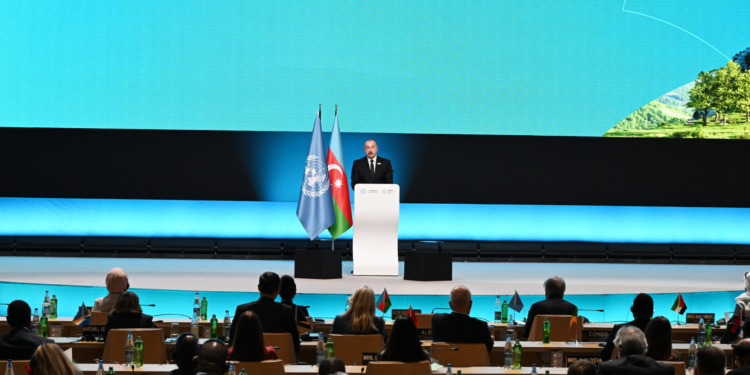The venue’s corridors were bustling with activity on the second day of the 29th session of the Conference of the Parties (COP29) to the UN Framework Convention on Climate Change (UNFCCC). Some of it was due to the opening of the high-level segment, but mostly it was negotiators hustling across meeting rooms and fueling up at the coffee carts. Parties rejected what could have been the basis for a draft text on the new collective quantified goal on finance. But they already mandated the preparation of draft text on other issues. Heads of State and Government started delivering their national statements.
In stark contrast to Monday, when delegates sat idly waiting for the agendas to be agreed upon, the second day of the conference featured bustling corridors and coffee queues.
The Leaders’ Summit drove some of the foot traffic, and the opening remarks by Azerbaijan’s President produced some fireworks. He denounced Western media’s “slander campaign” against the host country and recalled that European countries sought out Azerbaijan’s fossil fuel reserves to support the continent’s energy security in times of crisis.
Seemingly in an attempt to catch up on time lost, informal consultations convened well into the evening, with negotiators focused on issues such as the work programmes on mitigation and just transition meeting twice in one day. Across agenda items, parties gave mandates for the preparation of draft text — “surprisingly quickly for the process,” as one exhausted delegate noted leaving into the night.

During the two-week meeting in Baku, parties will be negotiating a New Collective Quantified Goal (NCQG ) — a more ambitious, transparent, and predictable climate finance target that better addresses the needs of developing countries for mitigation, adaptation, and loss and damage. There’s still much to settle, from the scale of funding to questions about responsibility: who contributes, and what exactly will the finance cover?
It’s also the last COP before the February 2025 deadline to update nationally determined contributions (NDCs), building momentum for ambitious national commitments. It is essential that NDCs reflect the outcomes of the global stocktake (GST) adopted at COP28, notably the landmark decision to transition away from fossil fuels.
Baku is a critical opportunity to accelerate global adaptation action as parties will be assessing progress of countries’ National Adaptation Plan (NAP) processes and identifying the way forward with a strong focus on implementation and support.
Negotiators will also revisit Article 6 of the Paris Agreement, aiming to establish stronger rules for global emissions trading.
IISD will be closely monitoring these discussions, offering support to negotiations and delivering daily reports on the decisions shaping global climate action.
What we want to see at COP29
What is the New Collective Quantified Goal and why does it matter?
It will be a central focus at COP29 as countries work to finalize a more ambitious climate finance goal, ahead of the 2025 deadline Parties set for themselves in the Paris Agreement.
IISD firmly supports a holistic approach to the NCQG process that emphasizes aligning all financial flows with the goals of the Paris Agreement. The framework should involve international finance, domestic public support measures, and innovative financial mechanisms to mobilize private capital. It should address the critical need to shift financial flows away from fossil fuels and toward leveraging private investments in the transition to net zero and enhancing climate resilience in developing countries. However, the core of the new goal must be the provision of public, grant-based climate finance that considers the needs and priorities of developing countries.
COP29 discussions should provide guidelines for equitable and inclusive climate finance, balancing the needs of mitigation and adaptation. The NCQG should provide sub-goals for mitigation, adaptation, and loss and damage, and integrate robust gender and human rights requirements and safeguards into the final decision.
A transparent, accountable, and effective monitoring framework for the NCQG will be essential to rebuild trust between recipient countries and contributors, and boost ambition in the next round of NDCs, supporting the global transition to a low-carbon, climate-resilient economy.
What is a must for revised nationally determined contributions?
With the February 2025 deadline for updated NDCs fast approaching, COP29 marks an important moment for parties to present their climate plans. The bottom line? Countries need to step up their ambition beyond previous submissions to meet the evolving global climate goals.
It is essential that they reflect the outcomes of the global stocktake (GST) adopted at COP28, which provided a roadmap for the next phase of climate action, including the historic decisions to transition away from fossil fuels, double energy efficiency and triple renewables.
NDCs from fossil fuel-producing countries should include details on reserves and extraction, phase-out pathways, as well as plans for a just transition.
To align with the Paris Agreement goal to hold global warming to 1.5C, at a minimum, countries should commit to halt fossil fuel expansion. NDCs should also include commitments to reform fossil fuel subsidies, including a commitment to develop national roadmaps that set clear policy-specific deadlines for phase-out or reform.
Above that, countries including an adaptation component in their NDCs should ensure it’s informed by National Adaptation Plan (NAP) processes. This helps to raise the profile on adaptation and improve mitigation-adaptation synergies. Where appropriate, NDCs should also reference countries’ updated National Biodiversity Strategies and Actions Plans (NBSAPs), for holistic and integrated action on climate and nature.
How can COP29 accelerate global adaptation action?
As climate change impacts people across the globe, there is a growing recognition that investing in adaptation now will save lives and minimize costs in the future.
Developing, strengthening, and implementing National Adaptation Plans (NAPs) is a critical way for countries to build climate resilience. Countries will continue assessing their progress in formulating and implementing NAPs and deliver a set of recommendations with the aim to accelerate adaptation actions, reduce vulnerability, and increase resilience. Since the last assessment in 2018, developing countries have made important progress on adaptation planning and implementation, so it is time to understand what’s working and what needs critical attention.
A successful outcome on adaptation at COP29 includes a balanced, robust outcome on the NAP assessment, highlighting the progress to date while acknowledging the need for a transition from planning to implementation, backed by the sufficient provision of financial and capacity support. This process must also highlight the importance of gender equality and social inclusion (GESI) in adaptation planning and implementation, as well as the importance of ensuring local and national efforts are aligned.
The conference in Baku will be also an important opportunity to advance work on the UAE-Belém work programme. This work program aims to come up with a set of indicators for measuring progress towards the targets of the UAE Framework for Global Climate Resilience. Countries and the convened expert group will continue the negotiations over the indicators at COP29, with an aim to reach an agreement at COP30 in Brazil.
What should we expect on public financial flows at COP29?
Fossil fuel subsidies continue to distort energy markets, undermining the competitiveness of clean energy technologies and stalling global decarbonization efforts. At COP26, countries agreed to pursue efforts towards the phase-out of inefficient fossil fuel subsidies, a pledge reaffirmed at COP27. Despite these commitments, global public financial support for fossil fuels surged to a staggering USD 1.7 trillion in 2022.
COP28 decisions added urgency to the pledge with clearer criteria on when subsidies might be justified, emphasizing the need to phase out “inefficient fossil fuel subsidies that do not address energy poverty or just transitions, as soon as possible.” Yet, the term “inefficient” remains vague, and the phrase “as soon as possible” lacks firm deadlines.
To make meaningful progress, the qualifier “inefficient” must be dropped entirely. Clear timelines will be critical to ensuring accountability and driving the transition forward.
The NCQG offers an opportunity to address fossil fuel subsidies, which undermine ambitious climate finance and act as a barrier to aligning financial flows with the Paris Agreement.
Outside the formal negotiations, we understand that there will be an update at COP29 on the work of the Clean Energy Transition Partnership which relates to how signatories are stepping up international public finance for clean energy while ending support for fossil fuels.
Related Articles: Finance and Equity Should Be the Core of COP29 Talks | Will COP29 Reach Consensus on More Funds for Climate Finance?
What’s next for the Just Transition Work Program?
At COP27, parties agreed to establish a work program on just transition for discussion of pathways to achieving the goals of the Paris Agreement. One year later, at COP28, parties defined and adopted the programme’s objectives.
The success of the Just Transition Work Programme hinges on the effective organization of its two annual roundtable dialogues from now until 2026.
At UNFCCC 60th session of Subsidiary Body for Implementation , parties were unable to agree on strengthening the programme’s modalities or developing a more structured work plan. Additionally, there was no consensus on how to involve relevant stakeholders through social dialogue or how international cooperation can be better organized. A lack of progress at COP29 could undermine the programme’s potential to accelerate just transition efforts.
At COP29, it is critical for parties to agree on ambitious and comprehensive modalities to put the Just Transition Work Programme on track. A clear, structured work plan, supported by active stakeholder engagement and international cooperation, is essential for delivering the discussions and outcomes necessary to scale and expedite just transition pathways globally.
What is Article 6 and why is it high on the COP29 agenda?
Article 6 of the Paris Agreement plays an important role in facilitating international cooperation on climate action through market and non-market mechanisms. By allowing countries to trade emissions reductions, it aims to enhance the cost-effectiveness of climate mitigation efforts while promoting sustainable development.
Article 6 is crucial at COP29 as it aims to finalize the rules for international carbon markets, ensuring transparency, environmental integrity, additionality and avoiding double counting, which is key for credible global emissions trading and cost-effective climate mitigation.
It is essential that, in the review of Article 6, the Parties establish clear safeguards, strong governance structures, and enhanced transparency. Article 6 mechanisms must be designed to accommodate the diverse contexts and priorities, including of forest-rich countries. We believe a key component of this is recognizing the needs and rights of Indigenous Peoples and Local Communities (IPLCs), ensuring they have fair access to revenues generated through Article 6 activities.
How do we make sure that climate action advances gender equality and human rights?
When climate action integrates gender equality and human rights considerations, it is more effective and sustainable. Across all the negotiation items at COP29, opportunities exist to ensure that social and gender inequalities that exacerbate vulnerability to climate change and limit opportunities to participate in solutions are addressed.
Key to this is the renewal of the Lima Work Programme on Gender and its Gender Action Plan (GAP). Negotiators at COP29 must agree on a framework for gender-responsive climate action that is ambitious and comprehensive, establishing links with other negotiating streams and providing the foundation for an updated, higher quality GAP. This new GAP must have a longer timeframe for implementation, concrete targets and indicators, and more clarity on roles and responsibilities. The decision at COP29 must recognize the context specific, structural, and intersectional nature of gender and social inequalities.
A renewed commitment to gender-responsive climate action is pivotal for the success of the Paris Agreement. Mainstreaming gender equality and human rights considerations, in an intersectional approach, across all negotiation items will be crucial for establishing linkages between the GAP and other areas of climate action.
** **
This article was originally published by the International Institute for Sustainable Development (IISD) and is republished here as part of an editorial collaboration with the IISD.
Editor’s Note: The opinions expressed here by the authors are their own, not those of Impakter.com — In the Cover Photo: Day 2 at COP29, November 12, 2024, Baku, Azerbaijan. Cover Photo Credit: COP29.










